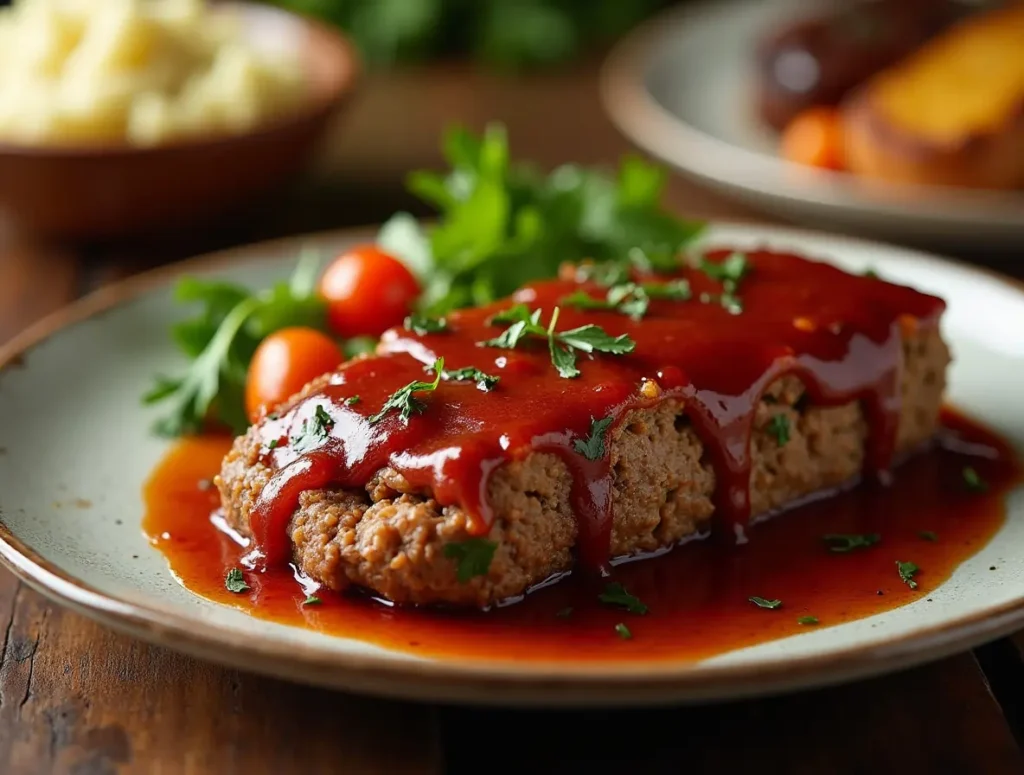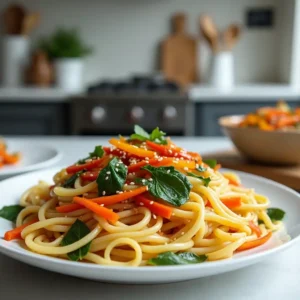Why a Great Meatloaf Sauce Makes All the Difference
The Role of Meatloaf Sauce in Flavor Balance
The sauce plays a key role in transforming your meatloaf from a basic dish into something truly memorable. With the right combination of ingredients, you can create a balanced flavor profile that highlights the savory depth of the meatloaf while adding sweetness, acidity, and umami richness. Imagine the contrast of a well-seasoned meatloaf paired with a tangy, slightly sweet glaze that caramelizes beautifully as it bakes. This sauce not only enhances the flavor of the meatloaf itself but also complements any side dishes on the plate.
Adding Visual Appeal
Beyond flavor, meatloaf sauce also contributes to the dish’s visual appeal. A shiny, glazed finish atop your meatloaf not only makes it look appetizing but also creates a restaurant-quality feel. Whether you’re serving family or hosting guests, a well-glazed meatloaf can instantly elevate the presentation.
Essential Ingredients for the Ultimate Meatloaf Sauce Recipe
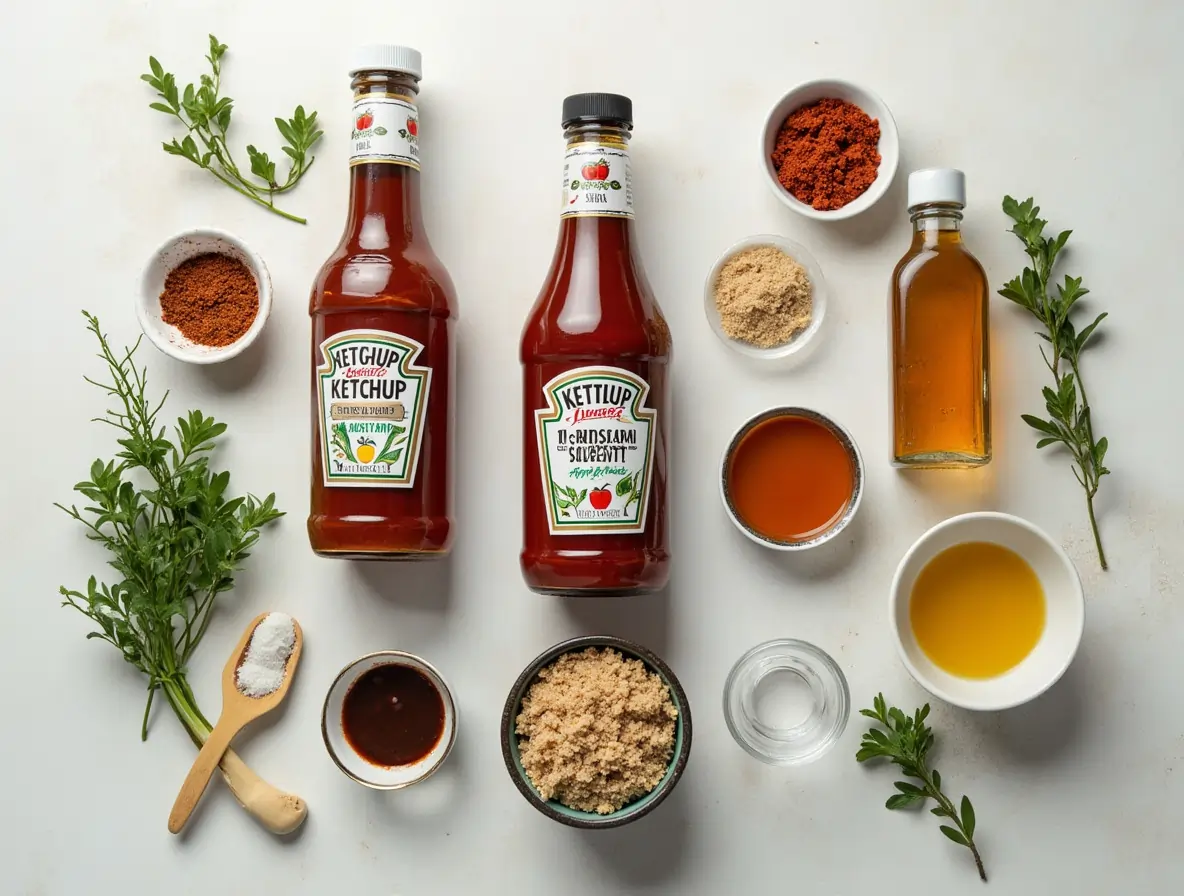
The Basic Ingredients You’ll Need
Creating the perfect meatloaf sauce is simpler than you might think. Most of the necessary ingredients are probably already in your pantry. Here’s a list of the key ingredients that come together to create a well-balanced and flavorful sauce:
Ketchup: This classic condiment forms the sauce’s base, offering both sweetness and acidity.
Brown Sugar: Adds a warm, caramel-like sweetness that balances the acidity of the ketchup.
Worcestershire Sauce: Brings umami and a touch of saltiness, enhancing the overall depth.
Apple Cider Vinegar: Provides a tangy kick, helping to brighten the sauce.
Optional Add-Ins for a Personalized Touch
Once you’ve mastered the basic sauce, you can experiment with additional flavors to suit your preferences. Consider adding:
- Mustard: A small amount of Dijon or yellow mustard adds a bit of sharpness and complexity.
- Smoked Paprika: This spice adds warmth and a hint of smokiness that pairs well with beef.
- Hot Sauce: For those who like a little heat, a dash of hot sauce can make the sauce more exciting.
- Garlic Powder: Provides a savory, aromatic element that complements the flavors of the meat.
These ingredients allow you to adjust the sauce according to your tastes, whether you prefer something sweeter, spicier, or a bit smoky.
Ingredient Table for Quick Reference
| Ingredient | Amount | Description |
|---|---|---|
| Ketchup | 1/2 cup | Base for sweetness and acidity |
| Brown Sugar | 2 tbsp | Adds depth and sweetness |
| Worcestershire Sauce | 1 tbsp | Brings umami and richness |
| Apple Cider Vinegar | 1 tbsp | Adds a tangy, balancing flavor |
| Mustard | 1 tsp | Optional, for sharpness and complexity |
| Smoked Paprika | 1/2 tsp | Optional, for smoky undertones |
| Hot Sauce | Few dashes | Optional, adds mild heat |
| Garlic Powder | 1/4 tsp | Optional, for added savory notes |
Step-by-Step Guide to Making the Perfect Meatloaf Sauce
Creating this sauce requires only a few minutes, but the results are transformative. Follow these steps to make a flavorful, balanced sauce that will take your meatloaf to new heights.
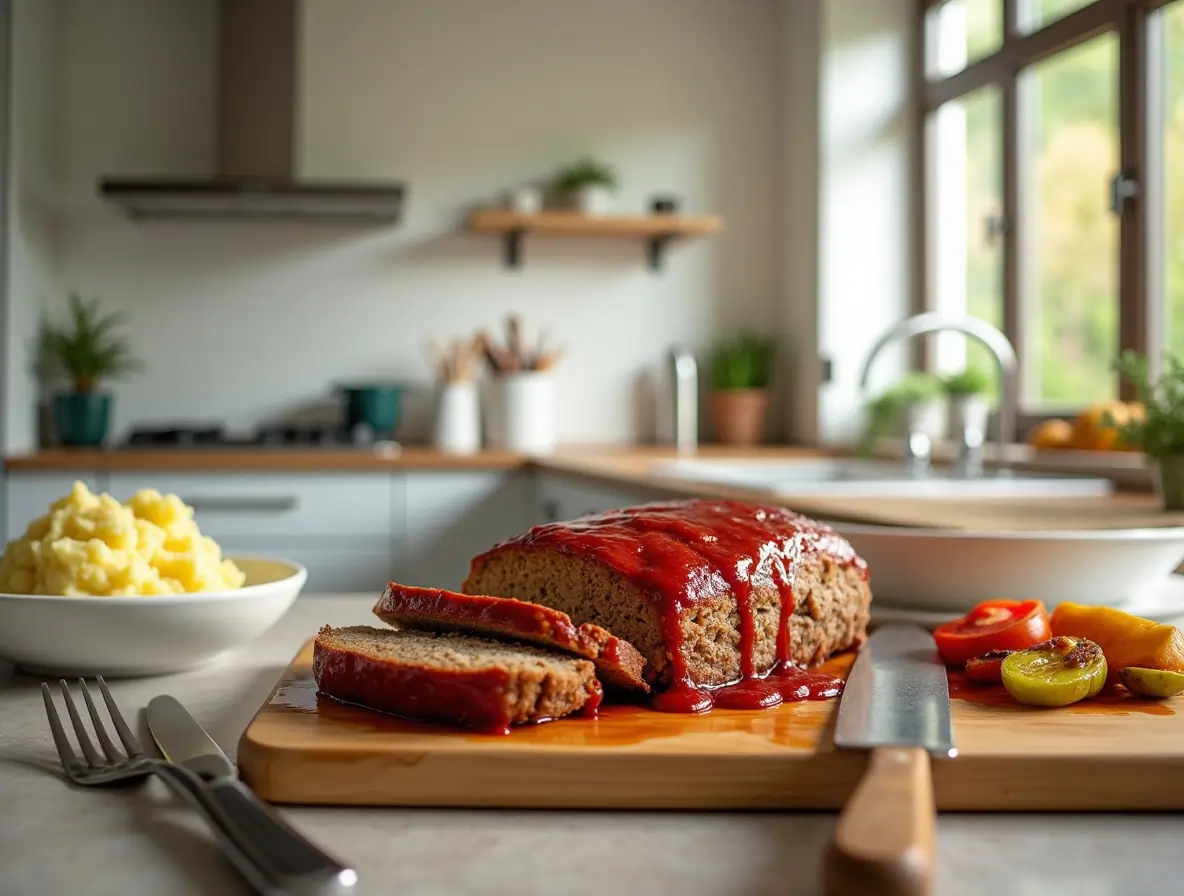
Step 1: Mix the Ingredients
In a medium bowl, combine ketchup, brown sugar, Worcestershire sauce, and apple cider vinegar. Whisk until the brown sugar dissolves completely, and the mixture has a smooth consistency. If you’re adding any optional ingredients, mix them in at this stage. Be sure to taste and adjust the flavors as needed, especially if you prefer a sweeter or tangier sauce.
Step 2: Heat the Sauce for a Deeper Flavor
While the sauce can be used straight from the bowl, heating it gently can enhance its flavor. Pour the sauce into a small saucepan and place over low heat. Allow it to simmer for about 5–10 minutes, stirring occasionally to prevent burning. Heating the sauce will help meld the flavors together, resulting in a more cohesive taste that complements the meatloaf. If you prefer a thicker glaze, continue simmering until it reaches your desired consistency.
Step 3: Apply the Sauce for Baking
Once your meatloaf is ready to bake, spread a layer of the sauce evenly over the top. This will create a glossy, caramelized crust as it bakes. Reserve some extra sauce to serve on the side, so everyone can enjoy as much as they’d like.
Cooking Techniques for the Perfect Meatloaf Sauce
Creating a standout meatloaf sauce requires not just quality ingredients but also an understanding of cooking techniques that enhance flavor and texture. Here are some essential techniques to consider:
- Balancing Flavors: A well-made sauce has a harmonious blend of sweet, tangy, and savory notes. Start with a base of ketchup for sweetness, then add Worcestershire sauce for depth, and finish with a splash of vinegar for acidity. Adjust the proportions to suit your taste.
- Heat Management: When heating your sauce, do so over medium heat to prevent burning. This gentle approach allows the flavors to meld together without compromising the quality of the ingredients.
- Experimentation: Don’t hesitate to try different spices or ingredients to make the sauce your own. For instance, adding smoked paprika can give it a delightful smoky flavor, while a dash of hot sauce can add a kick.
- Culinary Resources: If you’re looking to improve your culinary skills, consider exploring the resources offered by The Culinary Institute of America. They provide valuable insights into fundamental cooking techniques that can help you create not only a delicious meatloaf sauce but also a variety of other culinary delights. With their guidance, you’ll be well on your way to impressing your family and friends with your cooking prowess.
By mastering these techniques, you’ll ensure that your meatloaf sauce is not just good, but truly exceptional, ready to elevate your meatloaf experience.
Nutritional Information (Per Serving, based on 1 tablespoon of sauce)
- Calories: 25
- Total Fat: 0g
- Saturated Fat: 0g
- Trans Fat: 0g
- Cholesterol: 0mg
- Sodium: 150mg
- Total Carbohydrates: 6g
- Dietary Fiber: 0g
- Sugars: 5g
- Protein: 0g
Key Nutritional Notes:
- Calories: Each tablespoon of this meatloaf sauce adds minimal calories, making it a flavorful addition without overwhelming your meal.
- Fat Content: This sauce is virtually fat-free, making it a healthier alternative to creamy or oil-based sauces.
- Sodium: Depending on the brand of ketchup and Worcestershire sauce used, the sodium content can be higher; consider using low-sodium versions to reduce salt intake.
- Carbohydrates: The sauce contains carbohydrates primarily from the sugars in ketchup and brown sugar, contributing to its sweetness.
- Vitamins and Minerals: While this sauce doesn’t provide significant vitamins or minerals, it enhances the overall meal, which may include nutrient-rich ingredients in your meatloaf.
Note: Nutritional values may vary based on specific brands of ingredients used, cooking methods, and portion sizes. Adjustments to ingredients can also impact overall nutrition. For a more accurate analysis, consider using a nutrition calculator with the specific brands and quantities you use.
Tips for Customizing Your Meatloaf Sauce
One of the best things about homemade meatloaf sauce is that it can be customized to fit your family’s preferences. Here are some tips to help you create the perfect sauce for your meatloaf:
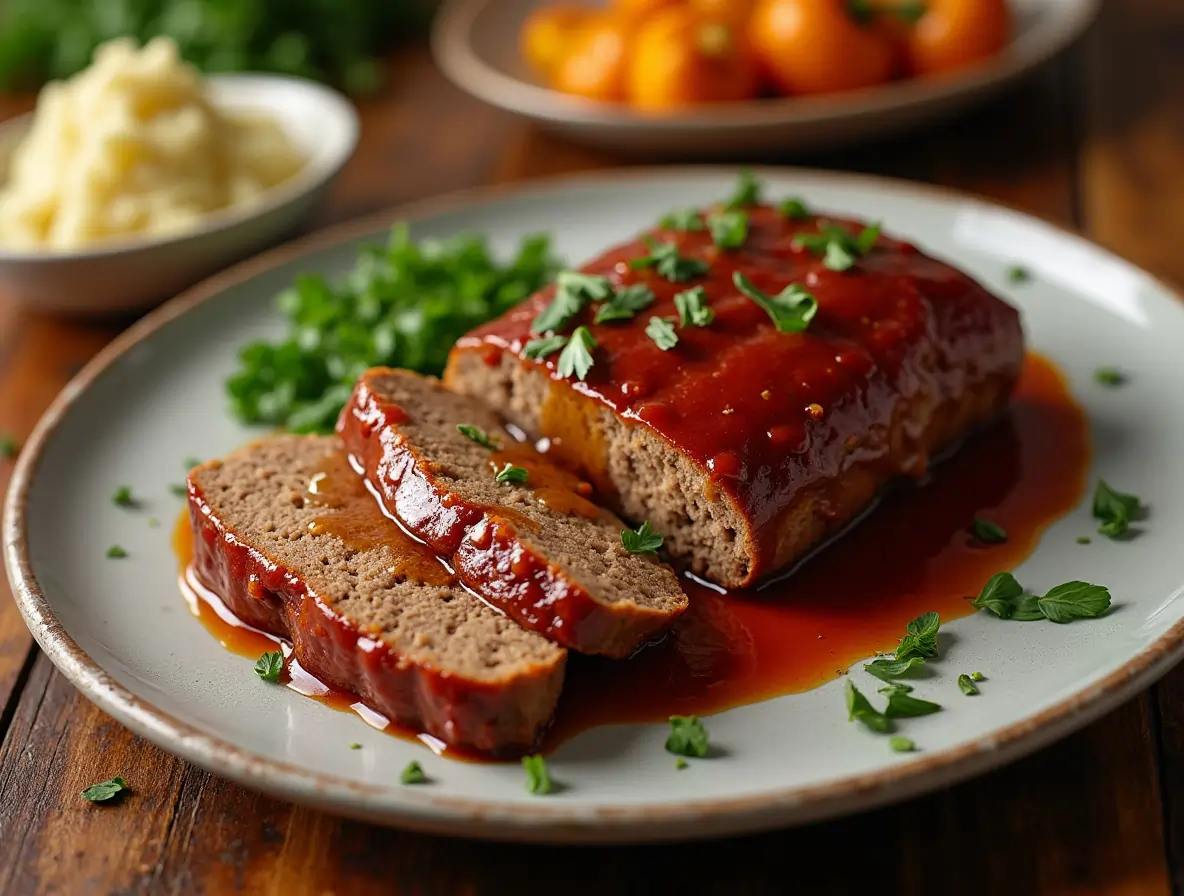
Make it Sweeter
If you’re looking for a sauce that leans more toward sweetness, try increasing the brown sugar or adding honey or maple syrup. This will give your sauce a rich, caramel-like sweetness that pairs well with the meatloaf’s savory notes.
Add Some Heat
If your family enjoys a bit of spice, a few dashes of hot sauce or a pinch of cayenne pepper can go a long way. Be cautious with the heat level; you want it to enhance the sauce without overpowering the other flavors.
Add Smoky Depth
A touch of smokiness can bring a whole new dimension to your sauce. Consider adding smoked paprika, or for a stronger smoky flavor, a few drops of liquid smoke. This addition pairs particularly well with beef, adding an almost barbecue-like quality to the meatloaf.
Serving and Pairing Suggestions
Once your meatloaf and sauce are ready, it’s time to think about presentation and pairings. The right serving technique and side dishes can make your meatloaf meal truly satisfying.
How to Serve Meatloaf with Sauce
For the most visually appealing presentation, apply a final layer of sauce over the meatloaf before slicing and serving. This extra layer not only enhances the flavor but also gives each slice a beautiful, glossy finish. Additionally, serve extra sauce on the side for anyone who loves a bit more. The sauce’s thick consistency makes it ideal for dipping or spreading over each bite.
Suggested Side Dishes to Pair with Meatloaf
Choosing complementary sides is key to a well-rounded meatloaf dinner. Here are some ideas that work particularly well:
- Mashed Potatoes: Creamy mashed potatoes are a classic pairing, balancing the richness of the meatloaf and sauce.
- Roasted Vegetables: Carrots, Brussels sprouts, or green beans roasted with olive oil and seasoning make for a flavorful, colorful side.
- Buttered Rolls or Bread: A warm roll is perfect for soaking up any extra sauce on the plate.
- Simple Green Salad: A light, fresh salad with a tangy vinaigrette can provide a welcome contrast to the hearty meatloaf.
Pro Tips for the Best Meatloaf and Sauce Combination
Achieving the perfect balance between your meatloaf and sauce requires a few tricks. Here are some expert tips to make your meatloaf shine:
Bake the Meatloaf with Sauce
Applying a layer of sauce to the meatloaf before baking not only enhances flavor but also helps prevent dryness. As the sauce cooks, it caramelizes on top of the meatloaf, creating a beautiful, shiny crust.
Choose the Right Consistency
The thickness of your sauce can make a big difference in how it pairs with the meatloaf. A slightly thick sauce will cling well to each slice, while a thinner sauce is best served on the side as a dip. Adjust the consistency by simmering the sauce longer or adding a splash of water if it becomes too thick.
Frequently Asked Questions (FAQs)
To help you master this meatloaf sauce recipe, here are answers to some common questions:
What’s the best meatloaf sauce recipe for kids?
If you’re cooking for a younger crowd, try making the sauce milder and a bit sweeter. Using ketchup, brown sugar, and a touch of vinegar, without any hot sauce or strong spices, creates a familiar, kid-friendly flavor.
Can I make this meatloaf sauce recipe in advance?
Yes, this sauce can be made up to two days ahead of time. Allowing it to sit in the fridge can deepen the flavors. Just store it in an airtight container, and reheat gently before serving.
What can I substitute for Worcestershire sauce?
If you don’t have Worcestershire sauce, soy sauce with a splash of lemon juice is a good alternative. This combination provides a similar umami flavor and richness.
How can I make the sauce thicker?
To thicken the sauce, continue simmering until it reaches your desired consistency. You can also mix a small amount of cornstarch with water and stir it into the sauce while heating.
Conclusion
You now have everything you need to make a delicious, flavorful meatloaf sauce that will transform your meatloaf into a standout dish. Whether you’re making it for a special occasion or just a comforting weeknight dinner, this sauce recipe will take your meatloaf to the next level. Experiment with the variations and tailor it to your taste, and don’t be surprised if this becomes the most requested meal at your table. If you enjoy exploring different sauce options, consider trying our Cajun Alfredo sauce recipe for another flavorful addition to your repertoire. Give it a try, add your personal twist, and share your feedback. Your journey to mastering the ultimate meatloaf sauce recipe starts here—enjoy!
